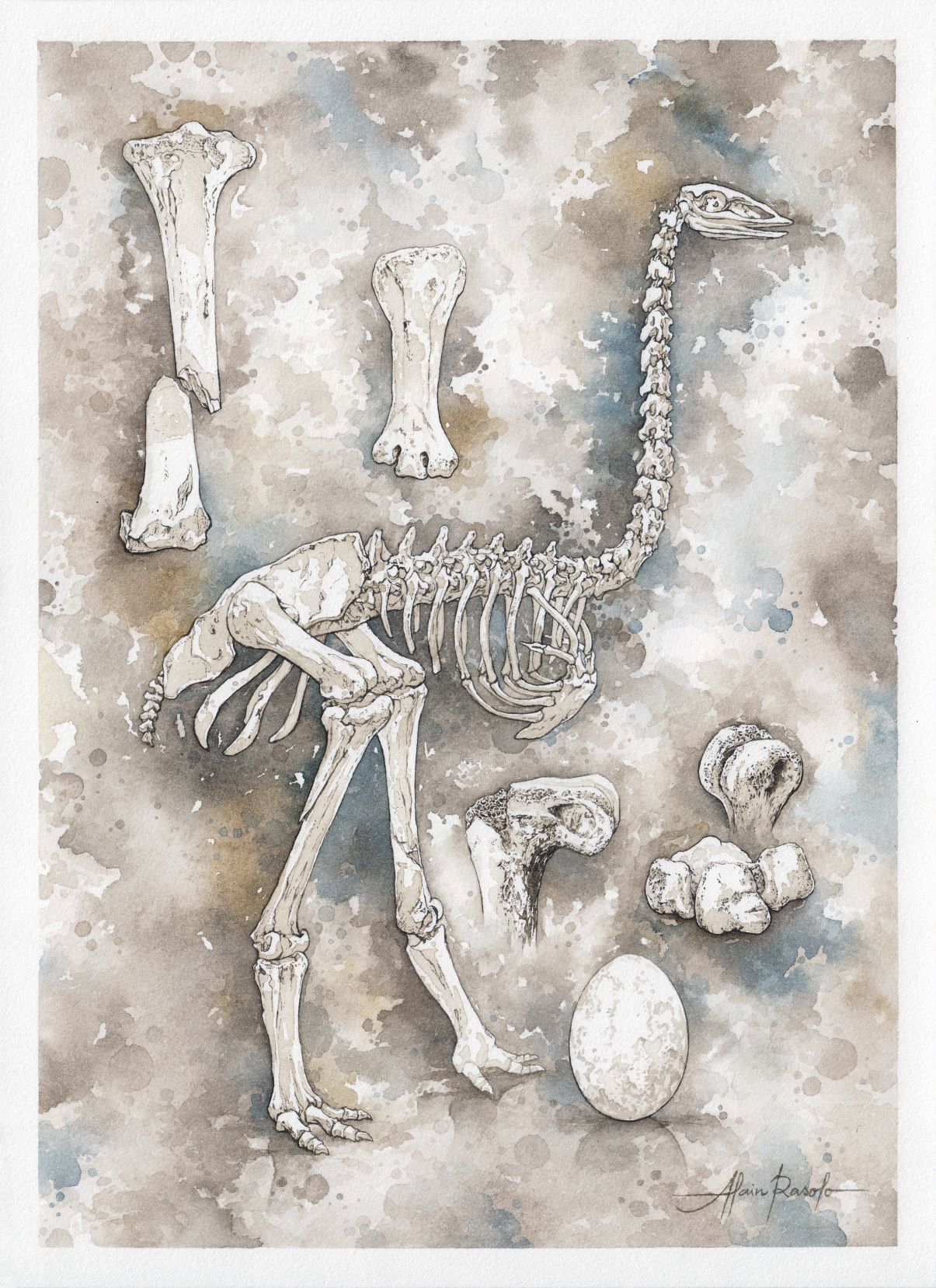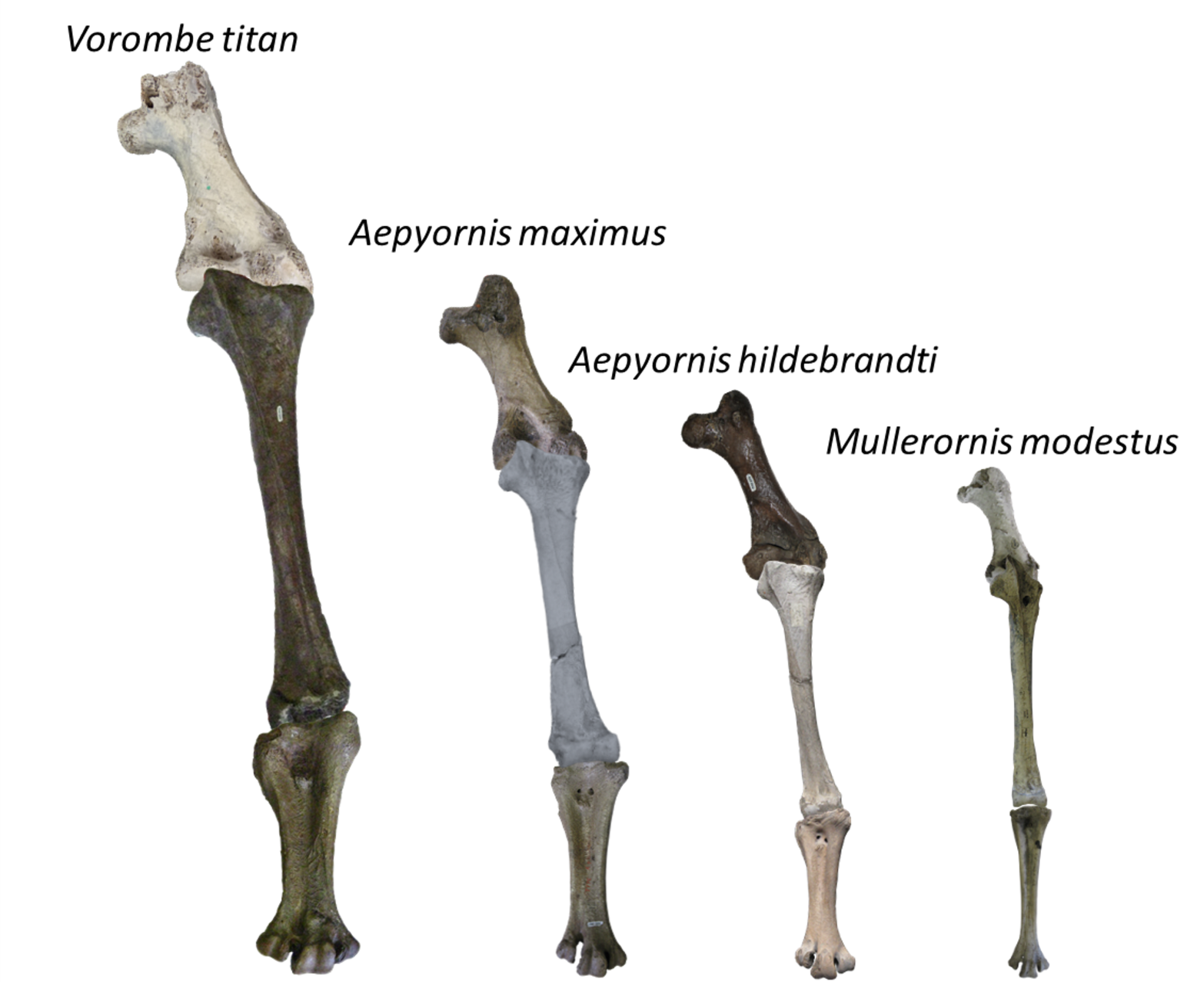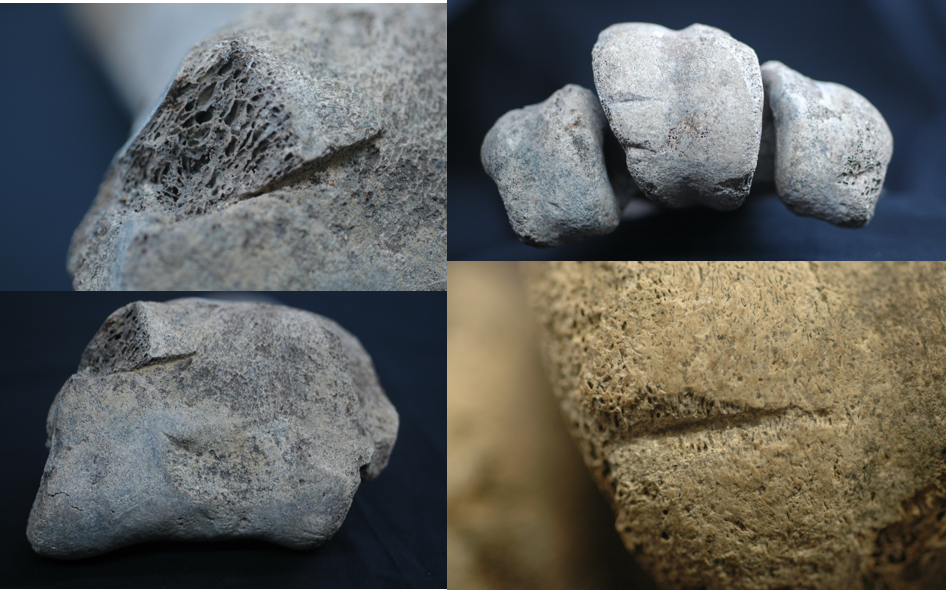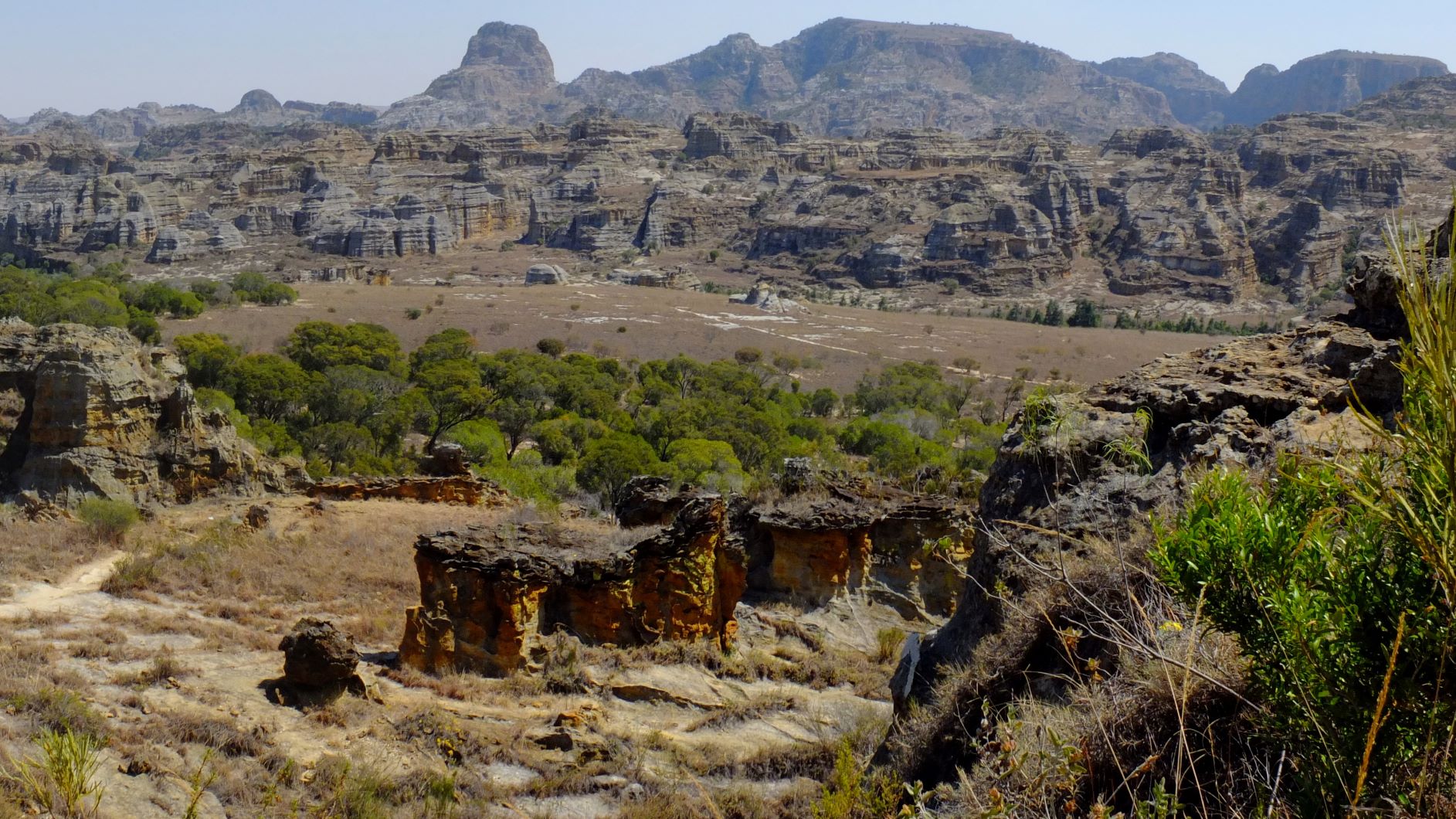To Kill an Elephant Bird: The Extinction of Madagascar's Avian Giants
By James Hansford in Paleobiology |
Paleobiology | Beasts of legend
The enormous Quaternary avian megafauna of Madagascar, the "elephant birds", have intrigued natural historians for centuries, inspiring mythical tales of "the Rukh", the science fiction of H.G. Wells and modern television documentaries by Sir David Attenborough. These extraordinary birds, that reached the upper limits of known avian body size and had the largest eggs of any known animal ever, disappeared within the last millennium. Owing to poor records and the considerable confusion brought about by competitive natural historians of the 19th century seeking to become the leading authority on these charismatic birds, they were almost forgotten to science for over 100 years, with little-to-no rigorous review of their diversity, life history or extinction process.
The first recorded account of a large bird in Madagascar comes from French colonial commandant, Étienne de Flacourt (1607-1660) who was resident in Fort Dauphin in the extreme south of the island. His 1648 publication "Histoire de la Grande Isle Madagascar" details a second-hand account of the "Vorounpatra" (Vouron = bird, patra= Ampatres or the Mandrare basin of the Androy region in the very south of the island). This bird was described as having keen vision, being too fast for men to catch and when approached "sought the loneliest of places". Just a few years later in 1667 another French colonialist known as Ruelle describes another encounter with a near mythical beast:
“We met a terrible winged dragon … one day out hunting with a soldier who was accompanying me, we saw one at the foot of a tree, that rose into the air as soon as we saw it, with a horrible hissing and red eyes of fire. When he had risen to the height of two spears he began to fall upon us, so I fired a shot that caused him to fall at my feet, with a frightful writhing about. My soldier companion killed it with another shot. It was 15 feet long. The head and body big like a calf tapering from the wings to the tail. Its scales were black and yellow; the wings were three feet in diameter. It had two rough and scaly feet. The body, we skinned to present it to Mr. Marquis de Mondevergue”.
It is unfortunate that Flacourt was never able to verify his account owing to his death during a voyage to France and that Ruelle’s specimen has disappeared. They are all too plausible to be accounts of late surviving elephant birds, yet cannot be utilised within a scientific discussion.
A written description extracted from the diary of Mr. John Joliffe from 1848 (surgeon on the HMS Geyser) details an encounter by M. Dumarele with an enormous egg being used to transport rum on a small boat near Port Leven. Dumarele was not able to purchase the egg but did purchase the contents and measured the liquid inside, finding it to be "13 wine quarts" in volume (over 9 litres by modern standards). The Sakalava people who owned the egg stated that they were found extremely rarely, and seeing the forest dwelling birds that laid them was an even rarer occurrence.

First (sub)fossil remains
The first remains to be studied by scientists were reported by Isidore Geoffroy-Saint-Hilaire in 1851. A distal fragment of an avian tarsometatarsus and three eggs purchased recovered separately from the south coast of Madagascar by merchant captain M. Abadie were presented in France and the UK. Saint-Hilaire named these birds Aepyornis maximus (or "Greatest high-bird") and made note that these eggs were the largest example from any known species and the hind limbs were of similar but more robust morphology to Moa (Dinornis). Coupled with Flacourt’s and Dumarele’s accounts, he described these remains to be recently deposited in sand dunes and wetlands, indicating that at least some birds may have been alive in unexplored regions at that time .
Saint-Hilaire’s hypothesis that the birds may not be extinct prompted several competing European expeditions to discover if there were any living examples. Whilst unsuccessful in finding a surviving individual or any viable eggs, these expeditions also incorporated archaeological and palaeontological investigations, yielding further examples of subfossil remains. As these specimens arrived in museum collections across Europe, scientists sought to describe the various morphologies in their individual collections, describing new species and publishing comparative measurements to support their diagnoses. The majority of these species were described as distinct taxonomic units on the basis of the commonly preserved leg bones, the femora, tibiotarsi and tarsometatarsi. However, as European collections were extremely limited in the mid-late 19th century, species were raised on that basis of unequivocal solitary elements (i.e. an eggshell fragment, a tarsometatarsus, or a femur).
Towards the end of the 19th century the proliferation of European missionaries in Madagascar and their construction of large buildings led to the discovery of numerous examples of Quaternary megafauna, including these giant birds. With much larger collections available for study scientists in Germany, the United Kingdom and France described two new genera and a number of species. A "conflict of authority" arose between British scientist Andrews, and the French anatomists Milne-Edwards and Grandidier to describe the largest of these birds. It should be noted that Andrews’ 1894 description of Aepyornis titan preceded the more expansive review of aepyornithid diversity of Milne-Edwards and Grandidier by just a few weeks.
In the early 20th century taxonomists sought to examine the relevance of proposed species and establish the true diversity of species again using comparative measurements and size classes perceived from distinct cranial specimens that had been accrued in collections. These revisions synonymised several taxa, reducing the known diversity to three species of the largest birds (Aepyornis) and four species of the more gracile birds (Mullerornis). Crucially, the original type specimen of Aepyornis maximus was not incorporated into these reviews, either as the specimen was missing from the Museum National d’Histoire Naturelle collection in Paris (as it is today) or it was deemed to be missing too many features to be of diagnostic value.
Modern analyses
The ancient DNA revolution of the last few decades has opened up the avenue of biomolecular research into recently extinct species. Much of this research was pioneered on other recently extinct giant birds, the Moa of New Zealand, sister taxa to the elephant birds. Unlike Moa, elephant birds lived in a tropical environment, which degrades DNA rapidly. Only in the last few years have sufficient fragments of DNA been extracted from elephant bird specimens to be able to assess their phylogenetic relationships, revealing that their closest living relatives were the Kiwi of New Zealand and the flighted dispersal of their ancestors in the Cenozoic .
Although these efforts have gone a long way to assessing the deep-time evolutionary history of elephant birds, the poor state of their museum collections, including the destruction of the largest collection at the Queens palace in Antananarivo in 1995 led to persistent underestimation of their species diversity and their distribution across Madagascar. In 2018, I published the first morphometric assessment of elephant birds, including type specimens, developing the only taxonomy available to be supported by quantitative data. This clarified the existence of at least four morphotypes relating to taxonomic units, including 4 species across 3 genera. Perhaps the most extraordinary finding of this assessment was that the size predictions for elephant birds were grossly underestimated and that the largest birds were distinctly separate from other remains beyond allometric scaling and represented a separate genus, now named Vorombe titan (Vorombe= "big bird" in Malagasy). Vorombe titan now holds the record as the largest ever bird weighing up to 860 kg .

Butchery marks
In conducting the taxonomic assessment of elephant birds, I visited the majority of museum collections around the world that held elephant bird skeletal material and made careful measurements of the hind-limb remains. Whilst collecting this data, I also observed several remains with evidence of tool marks from Christmas river (near Ilakaka village), which were consistent with the shape, orientation and wear of butchery marks. Radiometric dating of these remains showing signs of butchery reveals that they were exploited near their disappearance from the subfossil record around 1000 years ago, but crucially they also included specimens that dated to 10,500 years old. This evidence of human activity, at the start of the Holocene, is the earliest evidence of human presence on Madagascar, predating all other lines of evidence by at least 6000 years .

Undoubtedly, extending the archaeological record for Madagascar by such a large amount with this line of evidence is courting controversy as the debate over the longevity of human impact on the islands ecosystems continues. It is intriguing that the utilisation of tool marks and butchery of megafauna is now being used globally to prove the presence of humans much earlier than other lines of evidence offer. For example, the debate over human presence in North America was blown wide open by Steven Holen and co-authors in 2017, when they described a 130,000 year old archaeological site including fractured mastodon bones and stone . It is anticipated, that whilst the Holen evidence is an order of magnitude older than the oldest evidence of human presence in Madagascar, the butchery of elephant birds will be questioned and queried as some researchers maintain the view of the island as a pristine, paradise like ecosystem well into the late Holocene.
The previous early estimate of human presence in Madagascar were based upon the presence of stone tools in Anjohibe cave circa 4000 years ago . As stone tools cannot be directly dated, their stratigraphic context was key in interpreting their age. This line of evidence has met criticism from some members of the archaeological community as the activity of termites at the site has caused bioturbation of organic material in nest construction. Why stone tools may have been moved by the feeding habits of termites has yet to be justified by these critics however.
A recent assessment of tool marks of Madagascar’s fauna in the late Holocene has challenged evidence of butchery dating to 2400 years ago, and highlight that the prevalence of (metal) tool marks begins only around 1000 years ago, implying an exceptionally late arrival of humans and an immediate widespread colonisation, destruction of habitat and megafaunal extinction on a near continental scale . Such a blitzkrieg scenario would correspond to the rapid extinction of the Moas on NZ following human occupation at about 1300 CE. The tool marks on the elephant bird from Christmas river were published almost simultaneously with this study and its authors were not able to observe the Christmas river specimens whilst drawing their conclusions. However, the evidence from Christmas river meets the new criteria for assessing the validity of butchery marks as outlined in , even though they were from stone tools, rather than metal ones. In addition, unlike the Anjohibe tools and the Holen example, the specimens were directly dated at two separate radiocarbon facilities; therefore there is little room for doubt in accepting that humans were present and exploiting megafauna in Madagascar over 10,000 years ago.

It remains evident that the paucity of archaeological investigations of the early to mid-Holocene in Madagascar may be a clue as to why almost nothing is known about these early colonisers and the legacy of their impact before previously recognised settlements from both Borneo and East Africa. There appears to be no current genetic evidence to support their presence, much like the early colonisers of North America, and linguistic evidence offers no support either. It remains a mystery as to why this first wave of colonisers did not leave any apparent trace in the present-day Malagasy population that can only be resolved through future investigations.
A dogma crumbles
The late survival of elephant birds, hippopotami and giant lemurs up into the last millennium continues to confound concepts of humans rapidly causing extinction of megafauna via hunting, as proposed in the overkill hypothesis originally put forward by Paul Martin. Previous paradigms of late human arrival on Madagascar and rapid extinction of megafauna was a key example of overkill in an island ecosystem for Martin. With a growing body of evidence that contradicts this, we are now forced to revisit the causes of the demise of elephant birds as well as the hippopotami and giant lemurs. Although some scientists advocate the role of climatic change in the extinction of these species, their near simultaneous disappearance from the subfossil record around 1000 years ago does not correlate with significant island-wide climatic change and is therefore not discussed further here.
When considering the slow-tempo of elephant bird extinction it is valuable to contrast this process with the rapid extinction of the similarly sized and highly analogous Moa of New Zealand which occurred over the course of just 200 - 300 years. We know that both elephant birds and Moa displayed slow growth rates, as evidenced by lines of arrested growth in their cortical bone structure. Having a slow maturation rate and therefore delayed reproduction would have led to increased vulnerability to extinction as population recruitment rates would have been lower than for fast developing species. Although this is a factor in their vulnerability, it is however not a cause.
Although there is now a record of exploitation of elephant birds, this remains highly limited unlike Moa where archaeological sites demonstrate a clear and tightly constrained mass killing shortly before their disappearance. Several authors have previously proposed that the enormous eggs of elephant birds would have been prime protein resources and the vast swathes of eggshell found on coastal dune systems in the extreme south, combined with the presence of eggshell in archaeological middens and rock shelters, are evidence of large scale harvests by human. However, to date there is no evidence of the harvesting of viable eggs, and all radiocarbon dates of eggshell fragments from archaeological contexts predates the human activity at archaeological sites, suggesting that the fragments were not harvested from active nests .
From foragers to farmers and herders
Although there is a great deal more to learn about elephant bird ecology and life history, the information we do have, which contrasts with the Moa and New Zealand’s ecosystem, may offer insight into the differences of these huge birds' extinction patterns. Madagascar has approximately double the land mass of New Zealand and is often referred to as a mini-continent. It is possible that the simple factor of island size, and the range of available refugia in the rugged interior led to the sustained survival for so many centuries.
It is also important to consider the potential role of behaviour in relative risk of extinction. For example, both Madagascar and New Zealand had comparably sized endemic giant eagles, which likely predated both elephant birds and Moa respectively. However, unlike New Zealand, Madagascar had ground-based predators capable of killing elephant birds, in the form of the giant fossa (Cryptoprocta spelea). Perhaps the presence of these terrestrial predator led to reduced naïveté in elephant birds. If they displayed the aggressive behaviour comparable to their close relatives the Cassowaries, they could have been formidable prey, potentially even as dangerous as Ruelle’s account of a "dragon" suggests.
The most important evidence to consider in this example of an extinction process is that which directly precedes their disappearance. Although humans had been present in Madagascar for a considerable while around 1000 years ago, the scale of impact took a distinct shift at that time, coinciding with the use of metal tools. With the rapid, island-wide proliferation of human settlements, and the instigation of increased fire regimes, humans were radically altering the island's natural biomes, removing megafauna and burning forests to create agricultural pasture. Madagascar was never to be the same again, and the megafauna, including the elephant birds were in an inevitable final act. Some may have persisted in low-density, isolated refugia into the European colonial era, and perhaps Ruelle’s shots may have been the final interaction of humans and elephant birds, but without intervention it was already too late for these titans of the bird world.

Want to Know More?
Goodman SM and Jungers WL (2014) Extinct Madagascar: picturing the island's past University of Chicago Press
Responses